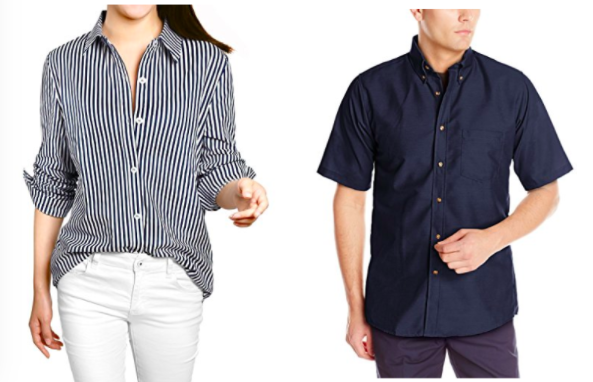Why Women’s Shirts Button Backward

We live in a world made for righties. Only about 10-15% of the population is left-handed; as a result, right-handed people design most of the products we use. Oftentimes, that means lefties are left (sorry) struggling with things the rest of us find simple; cutting paper with standard scissors, using a can opener, taking notes using a three-ring binder, or using a pencil to do just about anything (without your hand turning a silvery grey). But there’s one thing lefties are better at than are righties: putting on button-down shirts.
But only if you’re a woman.

Pictured above are two models wearing button-down shirts, one woman, one man. If you look carefully — pay particular attention to the unbuttoned buttons near the neckline on each — you’ll notice that the shirt buttons are on different sides. That’s standard across the board. For women, the buttons are on their left. For men, they’re on their right. As a result, it’s easier for left-handed women to button their shirts than for their right-handed counterparts to do the same.
But that probably wasn’t intentional.
On the men’s side, at least, there’s a generally accepted reason for where the buttons lay — warfare. According to the Atlantic, “the most common explanation comes from the fact that clothing, for wealthy men, often included weaponry,” and that meant the right hand had to be free to grab a hidden firearm, dagger, or the like. Further, the Atlantic continues, this is why “hand-in-waistcoat pictures [were] popular in the 19th century,” as “they involve, generally, the slipping of hand into an open area of the coat, right-to-left,” to grab that weapon tucked inside one’s coat if need be.
Women’s shirts, though, button the other way — and it’s not nearly as clear why. Handedness may have played a role after all — but not the handedness of the woman. Smithsonian explains:
During historical periods like the Renaissance and the Victorian Era, women’s clothing was often much more complicated and elaborate than men’s – think petticoats, corsets and bustles. But while rich men often dressed themselves, their female family members most likely had servants to help them put on their clothes, both out of luxury and necessity. To make it easier for servants to button up their employer’s dresses right, clothiers might have started sewing buttons on the opposite side.
Basically: the buttons were there to help servants — who were typically right-handed — dress the women in their care.
But there’s another leading theory as well. The TODAY show offers one by Chloe Chapin, a fashion historian. Per Chapin, “In the 1880s, it was fashionable for women’s clothing to look more traditionally masculine. However, it was illegal in many places to be dressed like a man in public, so perhaps having a difference in buttoning confirmed that you were wearing a female dress.”
Either way, if you’re a left-handed woman, this odd quirk of history gives a fashion result in your favor. It’s one of the rare times that the everyday items of life are designed in a way which benefits lefties.
Bonus fact: The most famous examples of hand-in-waistcoat portraits are those of Napoleon Bonaparte — the one linked-to above is of him, for example. Napolean’s other claim to fame — beyond ruling France, of course — is his height; he was notoriously short. Except: he wasn’t. Napoleon is often listed at 5’2″, giving rise to the myth. But that was in French feet/inches, a system of measurement which fell out of favor after the French Revolution. The modern English equivalent is about 5’6″, which, while on the shorter side for a man by today’s standards, was probably no more than a tick below average height at the time.
From the Archives: The People That Have No Rights: They live in a world without lefts, either.
